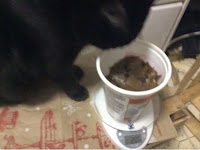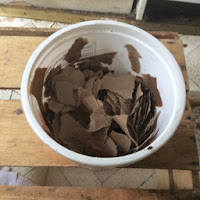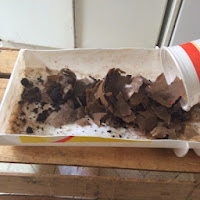Our new adventures: producing food using low cost and homemade aquaponics/ hydroponics systems, worm composting and spreading the word on local food for all by becoming a non-profit.
Friday, January 30, 2015
Sunday, January 25, 2015
Worm challenge - update 1
Friday, January 23, 2015
Look what I found sticking out of the worm bucket for the school !
Thursday, January 22, 2015
The 2 worm challenge
 |
| See my little helper checking my work. |
The worms have to be immature, as mature worms can carry fertilized eggs, which may skew the experiment.
Sunday, January 18, 2015
Vertical farm and compost update
 On the nutrient side, I have just brewed some compost tea using 2 cups and 1/4 of worm compost in 1 quart of water, and nitrite and nitrate still read below the detection level in the compost tea , however, in the system, the level of nitrate is increasing. I did add 4 mL of ammonia last week, and again this week, but I think next week I will not add any, and see what happens. I recall that during December, I was adding 1 mL everyday of ammonia and it didn't seem to increase nitrates at all, I am starting to think that the compost tea brings some nitrogen in the system, but not in the form of ammonia, nitrite or nitrate, but that the system processes it into nitrate. Also, there is a little pick of nitrite.
On the nutrient side, I have just brewed some compost tea using 2 cups and 1/4 of worm compost in 1 quart of water, and nitrite and nitrate still read below the detection level in the compost tea , however, in the system, the level of nitrate is increasing. I did add 4 mL of ammonia last week, and again this week, but I think next week I will not add any, and see what happens. I recall that during December, I was adding 1 mL everyday of ammonia and it didn't seem to increase nitrates at all, I am starting to think that the compost tea brings some nitrogen in the system, but not in the form of ammonia, nitrite or nitrate, but that the system processes it into nitrate. Also, there is a little pick of nitrite.Wednesday, January 14, 2015
The ponic system, 3 months in!
| Collard green BIIG |
| Tomato and pepper seedlings |
Tuesday, January 6, 2015
First year of indoor composting (ok not year, just 4 months)
| The compost |
| Worm crate |
One day, my beloved lady suggested I'd start a worm composting bin. After coming back from my utter surprise, I quickly started the bin. That was back in august. After a modest start with 2 packs of worms form a fish bait shop, I got a half pound or red wigglers from the Lower East Side Ecology Center. I applied the basic principles gleaned from the Internet experts and a dose of common sense (or so I hope). So there is the results from the first "year":
Input: 1 pound and 3ounces of worms (the bait shop worms included)
5 kg (11 pounds) - dry weigh - of paper, cardboard, wood dust, dried leaves (actually more than that since i started to record this only later)
 20 kg (45 pounds) of diverse food scraps, including supposed no-noes like onion peel, lemon, garlic ... in moderation, there is no problem really, and anything else vegetable based, and used coffee grounds
20 kg (45 pounds) of diverse food scraps, including supposed no-noes like onion peel, lemon, garlic ... in moderation, there is no problem really, and anything else vegetable based, and used coffee grounds
Unknown amount of water - as I almost always put the scraps in the blender, I add some water for the blender to be able to do its job
Output: 3.18 kg (7 pounds) of dark moist earthy smelling dirt!
The crate is fairly small (~1 x 1.5 x 1 ft, or 11 gallons, or 31 x 48 x 31 cm, or 46 L); and because it is indoor, I have been prudent in adding too much food (~140 g a day or 0.3 lbs in average) . If I can, I'd like to experiment with a larger system, maybe 2 x 3 x 2 feet and see how much can be put in it while following a similar feeding rate (I guess per surface unit).
The compost was used for a couple of house plants, to start seeds, and to brew compost tea. With the solids left from making compost tea -which contains some small worms and cocoons - I just started a composting bucket for the school project.
Sunday, January 4, 2015
Happy New year and update
Subscribe to:
Comments (Atom)



